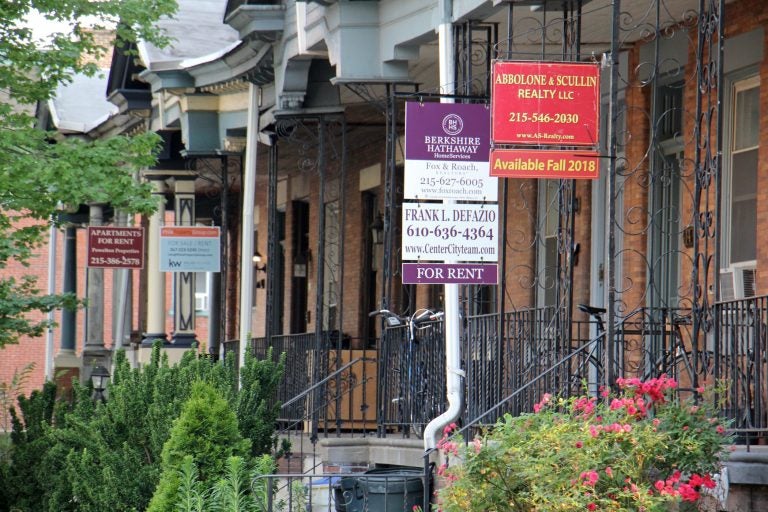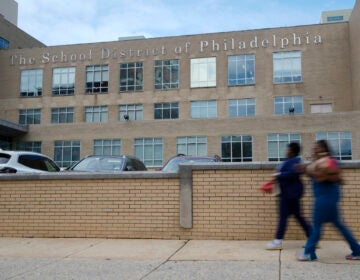Philly real estate community reacts warily to school district planning process
Last week’s news that the Philadelphia School District could move catchment boundary lines piqued the interest of parents and those that sell them homes.
Listen 2:08
Rowhomes at 34th and Spring Garden Street for sale or rent. (Emma Lee/WHYY)
At the corner of 6th and Christian streets in Philadelphia’s Bella Vista neighborhood, the beeping of backhoes is almost like the chirp of native birds: constant, unmistakably loud.
This intersection alone boasts a new Montessori-style pre-K, a strip of rehabbed townhomes, and a bustling coffee shop — all signs of the boom that has sent local real estate prices soaring.
Sitting at said coffee shop, real estate agent Jeanne Whipple notes another important, and invisible, driver of development.
“We’re just outside the Meredith catchment,” she said, gesturing northward.
That’s a major distinction for Philadelphia parents, realtors, and developers.
For those of you who don’t speak the Philadelphia dialect of education-ese, “Meredith” is short-hand for William Meredith, an acclaimed K-8 school in the Queen Village neighborhood. People pay a premium to buy homes in the Meredith attendance or “catchment” zone, where, by one estimate, housing prices have climbed 261% since 2001.
Meredith’s popularity has created a problem: The school now has more students than it’s supposed to hold. And it’s not the only school like this in South Philadelphia, where the twin forces of gentrification and immigration have filled some public schools past their architectural brims.
So it’s no surprise that the corner of 6th and Christian also sits in “Study Area 1,” meaning it’s in one of the first neighborhoods that will go through the unprecedented planning process announced last week by School District of Philadelphia officials.
The just-unveiled “Comprehensive School Planning Review” will wind through every Philadelphia neighborhood over the next four years.
Under this new system, local committees will review enrollment predictions made by an outside firm and make planning recommendations based on those predictions.
Those recommendations will eventually go to the school board for a final decision. They could include changes in grade configurations, school openings, school closings, and even the rare shift in school boundary lines.
The latter is of particular interest to the real estate community, which is already buzzing over “Study Area 1” and the district’s planning announcement.
Changes in school boundaries could change real estate prices
One way to alleviate overcrowding in places like the Meredith catchment would be to shrink the catchment area, and thus the number of families eligible to attend the school. But any change in boundary lines could also shift real estate prices, and potentially hurt those who’ve paid extra to live near the city’s most desirable public schools.
Add in the fact that these schools serve an increasingly white and affluent student population — with parents who have serious political capital — and the recipe for fireworks is obvious.
“You’ll have militant people, angry people,” said Mike McCann, a longtime agent and an associate broker with Keller Williams. “Because there’s nothing more important than your child.”
It’s hard to find a clear consensus in Philadelphia’s real estate and development circles about the school district’s planning announcement. Some predict a backlash that could dampen the market in some neighborhoods. Others are more sanguine, saying they’ll believe the hype about shifting boundary lines when they actually see it happen.
But it’s clear, the news is reverberating.
“There’s a lot of buzz,” said Leo Addimando, managing partner of Alterra Property Group and vice president of the Building Industry Association of Philadelphia.
Allison Fegel, a South Philadelphia resident and one of Jeanne Whipple’s colleagues at Elfant Wissahickon Realtors, has already heard from clients unsettled by the district’s announcement.
“Their head was in a tizzy,” Fegel said.
Jeff Block, an agent and associate broker with Compass real estate, sent an email blast last week to his clients titled “Mother of all Battles?”
“This could be the mother of all battles,” Block wrote. “As in, try to tell a mother (or father) that they no longer live in a certain Philly School Catchment. Or try to tell a homeowner that their property is no longer in a certain catchment.”
‘It creates uncertainty’
All of this comes with a major caveat, Block said in an interview: No one knows yet if the district will actually move boundary lines.
District officials emphasize that new catchment lines are just one option on the table, and that community leaders will have a say in how these decisions play out in each neighborhood. In the end, it’s possible the lines in “Study Area 1” remain put.
The short-term question, then, is whether the very idea of new lines will give buyers and developers cold feet.
Block thinks the real estate market will continue to chug along until officials actually shift lines. Since the district has rarely shifted boundaries in the past — and even then, usually as a response to school closings — Block doesn’t believe the market will budge much.
Developer Leo Addimando buys that logic for companies, like his, that tend to build rental properties.
But he does think this news could scare away builders who focus on townhomes and condos, the types of developments that attract young families.
“I think it creates uncertainty,” said Addimando. “Uncertainty and unpredictability are the enemies of real estate development.”
McCann, with Keller Wiliams, predicts “stress, tension, [and] negativity” until the district makes its final decisions. And he thinks it would be unfair for those final decisions to include any boundary changes.
“You don’t change the rules in the middle of the game,” McCann said.
If that is indeed the prevailing thought of agents and developers, another question arises: How involved will developers be in the upcoming deliberations, which will span the next year?
Right now, each study area will convene a committee that consists of local parents, school officials, city officials, and politicians. There’s no formal carveout for realtors or developers, though some clearly think the real estate community should be at the table.
“As developers, we’re not going to want to just sit back and watch the action,” Addimando said. “We’re going to want to be part of the conversation.”
High stakes
Addmiando’s company, Alterra, has donated to several public schools to help them make capital improvements. That includes Andrew Jackson School in South Philadelphia, where enrollment soared over the past decade. And although Addimando said his company’s donations weren’t geared to boost the value of his rental projects, he does think school improvements have been a major boon for townhome and condo developers.
By virtue of starting this review process in schools with overcrowding concerns, district officials are also starting their work in an area where realtors and developers take an especially keen interest.
In other words, the stakes are high.
Philadelphia Mayor Jim Kenney talks frequently about keeping young parents in the city, especially those who have the money to decamp for the suburbs. He sees a healthy public school system as a key part of the city’s argument to those families.
In essence, Kenney is talking about the relatively affluent couples who populate many of the neighborhoods in “Study Area 1.” The study area includes four zip codes — 19145, 19146, 19147, and 19148 — where housing prices have risen between 46.4 percent and 93.1 percent over the last decade, according to research by the Pew Charitable Trusts.
The district’s planning process could buoy the reputation of public schools in these neighborhoods, or deflate it. The swirl of activity around 6th and Christian streets in Bella Vista could hasten or slow depending on the decisions made over the coming year.
Agents Jeanne Whipple and Allison Fegel believe the anxiety will pass and those who’ve flocked to South Philadelphia’s schools will continue to plant their roots in the city.
“Your house isn’t shrinking. Your beautiful street’s not going away,” Whipple said. “You still have the sticks and bricks.”
Fegel plans to be transparent with clients about the district’s plans, while also advising them to explore schools outside their preferred catchments so they don’t get too caught up in the frenzy.
“You might end up in another school and it’s gonna be OK,” she said.
WHYY is your source for fact-based, in-depth journalism and information. As a nonprofit organization, we rely on financial support from readers like you. Please give today.







